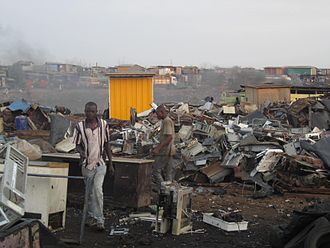
Back Agbogbloshie Catalan Agbogbloshie Czech Elektronikschrottverarbeitung in Agbogbloshie German Agbogbloshie Spanish Agbogbloshie French Agbogbloshie GPE Agbogbloshie ID Agbogbloshie Italian アグボグブロシー Japanese 아그보그블로시 Korean
Agbogbloshie | |
|---|---|
Town | |
Location of Agbogbloshie, Ghana in Greater Accra Region | |
| Coordinates: 05°32′42.0″N 00°13′30″W / 5.545000°N 0.22500°W | |
| Country | |
| Region | Greater Accra Region |
| District | Korle-Klottey Municipal District |
| Time zone | UTC0 (GMT) |

Agbogbloshie was the nickname of a commercial district on the Korle Lagoon of the Odaw River, near the center of Accra, Ghana's capital city in the Greater Accra region, before it was demolished by the Ghanian government in 2021.[1] Near the slum called "Old Fadama", the Agbogbloshie site became known as a destination for externally generated automobile and electronic scrap collected from mostly the western world. It was a center of a legal and illegal exportation network for the environmental dumping of electronic waste (e-waste) from industrialized nations. The Basel Action Network, a charitable non-governmental organization based in Seattle, has referred to Agbogbloshie as a "digital dumping ground", where millions of tons of e-waste were processed each year.[2]
The most exhaustive study of the trade in used electronics in Nigeria, funded by the United Nations Environment Programme (UNEP) and the Basel Convention, revealed that, out of 540,000 tonnes of informally processed waste electronics, 52% of the material was recovered.[3]
According to statistics from the World Bank, in large cities like Accra and Lagos the majority of households have owned televisions and computers for decades.[4] The 2012 UN Report "Where are WEEE in Africa" (WEEE meaning Waste Electrical and Electronic Equipment) disclosed that the majority of used electronic equipment in African dumps had not been recently imported as scrap, but had originated from those African cities.[5]
Agbogbloshie is situated on the banks of the Korle Lagoon, northwest of Accra's Central Business District.[6][7] Roughly 40,000 Ghanaians inhabited the area, most of whom were migrants from rural areas.[8][6] Due to its harsh living conditions and rampant crime, the area was nicknamed "Sodom and Gomorrah".[9]
The Basel Convention prevents the transfrontier shipment of hazardous waste from developed to less developed countries. However, under Annex Ix, B1110, the Convention specifically allows export for reuse and repair. While numerous international press reports have made reference to allegations that the majority of exports to Ghana are dumped, research by the US International Trade Commission found little evidence of unprocessed e-waste being shipped to Africa from the United States.[10]
Whether domestically generated by residents of Ghana or imported, concern remained over the methods of waste processing — especially burning — which release toxic chemicals into the air, land and water. Exposure is especially hazardous to children, because those toxins are known to inhibit the development of the reproductive system, the nervous system and, especially, the brain. Concerns about human health and the environment of Agbogbloshie continue to be raised because the area remains heavily polluted.[6][11][12]
In the 2000s, the Ghanaian government, with new funding and loans, implemented the Korle Lagoon Ecological Restoration Project (KLERP), an environmental remediation and restoration project that was designed to deal with the pollution problem by dredging the lagoon and Odaw canal to improve drainage and the outfall into the ocean.[13]
- ^ Boakye, Edna Agnes (2021-05-20). "Relocate to Adjen Kotoku within seven weeks – Onion traders in Accra ordered". Citinewsroom - Comprehensive News in Ghana. Retrieved 2021-05-20.
- ^ "Ghana: Digital Dumping Ground". FRONTLINE/World. PBS. Retrieved 3 January 2022.
- ^ Ogungbuyi, Olakitan; Nnorom, Innocent Chidi; Osibanjo, Oladele; Schluep, Mathias (May 2012). e-Waste Country Assessment Nigeria (PDF) (Report). Secretariat of the Basel Convention.
- ^ "World Development Indicators: The information society".
- ^ "Basel Convention: Where are WEee in Africa?" (PDF).
- ^ a b c Safo, Amos. "End of the Road for 'Sodom and Gomorrah' Squatters". News From Africa. Archived from the original on 18 July 2011. Retrieved 15 March 2011.
- ^ Afenah, Afia. "(Re)claiming Citizenship Rights in Accra, Ghana". DPH. HIC (Habitat International Coalition). Retrieved 15 March 2011.
- ^ "Time up for Sodom and Gomorrah". Peace FM Online. Daily Graphic. 4 September 2009. Archived from the original on 11 March 2012.
- ^ Hugo, Pieter (July 24, 2011). "Ghana's e-Waste Dump Seeps Poison". Newsweek.
- ^ U.S. International Trade Commission (February 2013). Used Electronic Products: An Examination of U.S. Exports (PDF) (Report). 4379.
- ^ "Poisoning the poor - Electronic waste in Ghana". Greenpeace. 5 August 2008. Archived from the original on 11 April 2020.
- ^ Dogbevi, Emmanuel K. (7 June 2010). "E-waste in Ghana – How many children are dying from lead poisoning?". Ghana Business News. Retrieved 3 January 2022.
- ^ "THE ENVIRONMENTAL IMPACT ASSESSMENT [EIA] STUDY FOR THE DREDGING IN THE ODAW BASIN" (PDF). Ministry of Works and Housing: 5. February 2019.
